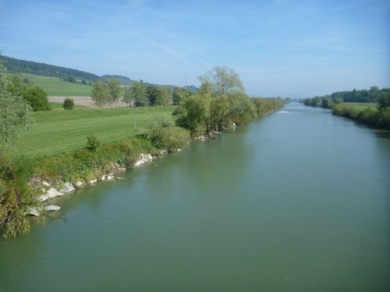Difference between revisions of "Thur"
(→Measures selection) |
(→Measures selection) |
||
| Line 15: | Line 15: | ||
Parts of the Thur river were restored, as for example in 2002 on a 2 km stretch close to the villages of Niederneunforn and Altikon (i.e. stretch selected as the restored site for the Reform project). The river was widened on one or both sides of the main river channel. Along the course of the river, embankments were removed to provide a larger space to the river. Additional wood structure were added to enhance the ability of the river to meander. Both are expected to increase diversity of instream habitats and corresponding biota. A higher interaction between the river and the old-disconnected floodplain is expected to happen. To date, hydromorphological and biological indicators both suggest an increase in river quality and conditions after restoration. Fish species like the ''Chondrostoma nasus'' and bird species like the ''Actitis hypoleucos'' found habitats within the new landscape [1]. Socio-economic studies will complement ecological approaches, to assess the benefits or restoration costs for local citizens. Moreover, long-term ecological studies will permit to study in details the success or failure of restoration. The Thur restoration is a clear example of restoration management in Switzerland, providing information concerning restoration effects, and stimulating current and future studies. | Parts of the Thur river were restored, as for example in 2002 on a 2 km stretch close to the villages of Niederneunforn and Altikon (i.e. stretch selected as the restored site for the Reform project). The river was widened on one or both sides of the main river channel. Along the course of the river, embankments were removed to provide a larger space to the river. Additional wood structure were added to enhance the ability of the river to meander. Both are expected to increase diversity of instream habitats and corresponding biota. A higher interaction between the river and the old-disconnected floodplain is expected to happen. To date, hydromorphological and biological indicators both suggest an increase in river quality and conditions after restoration. Fish species like the ''Chondrostoma nasus'' and bird species like the ''Actitis hypoleucos'' found habitats within the new landscape [1]. Socio-economic studies will complement ecological approaches, to assess the benefits or restoration costs for local citizens. Moreover, long-term ecological studies will permit to study in details the success or failure of restoration. The Thur restoration is a clear example of restoration management in Switzerland, providing information concerning restoration effects, and stimulating current and future studies. | ||
| − | [[File:Thur_unrestored.jpg| | + | [[File:Thur_unrestored.jpg|390px|thumb|left|Unrestored site, view upstream, autumn 2013]] |
==Socio-economic aspects== | ==Socio-economic aspects== | ||
Revision as of 09:13, 27 May 2014
Thur
Site description
The Thur is a 127 km long river flowing from the Swiss Alps in the north east of Switzerland. It is a tributary of the Rhine river which also originates in the Swiss Alps and ends in the North Sea. The Thur is the largest Swiss river without natural or artificial reservoirs along its course. Its discharge is similar to unregulated alpine rivers, the water level can therefore increase rapidly during rain events or snowmelt. For agricultural purposes and protection of residential areas, the Thur river was embanked in the late 19th century and its natural floodplain was drastically reduced. To date, important efforts are made to restore a natural morphology within the river. The aims are to increase natural protection against floods, and to increase natural processes and habitat diversity.
Measures selection
Parts of the Thur river were restored, as for example in 2002 on a 2 km stretch close to the villages of Niederneunforn and Altikon (i.e. stretch selected as the restored site for the Reform project). The river was widened on one or both sides of the main river channel. Along the course of the river, embankments were removed to provide a larger space to the river. Additional wood structure were added to enhance the ability of the river to meander. Both are expected to increase diversity of instream habitats and corresponding biota. A higher interaction between the river and the old-disconnected floodplain is expected to happen. To date, hydromorphological and biological indicators both suggest an increase in river quality and conditions after restoration. Fish species like the Chondrostoma nasus and bird species like the Actitis hypoleucos found habitats within the new landscape [1]. Socio-economic studies will complement ecological approaches, to assess the benefits or restoration costs for local citizens. Moreover, long-term ecological studies will permit to study in details the success or failure of restoration. The Thur restoration is a clear example of restoration management in Switzerland, providing information concerning restoration effects, and stimulating current and future studies.
Socio-economic aspects
Socio-economic studies will complement ecological approaches, to assess the benefits or restoration costs for local citizens.
Contact person within the organization
Prof. Mario Schirmer, Eawag, Überlandstrasse 133, CH 8600 Dübendorf, Switzerland
Extra background information
Link to project website:
http://www.cces.ethz.ch/projects/nature/Record
http://www.rhone-thur.eawag.ch/
References
European Centre for River Restoration (ECRR). 2008. ECRR Addressing practitioners
Related Measures
- Reduce anthropogenic flow peaks
- Shorten the length of impounded reaches
- Link flood reduction with ecological restoration
- Establish environmental flows / naturalise flow regimes
- Widen water courses
- Allow/increase lateral channel migration or river mobility
- Remeander water courses
- Shallow water courses
- Initiate natural channel dynamics to promote natural regeneration
- Remove sediments
- Remove bank fixation
- Remove or modify in-channel hydraulic structures
- Recreate gravel bar and riffles
- Develop riparian forest
- Adjust land use to develop riparian vegetation
- Revegetate riparian zones
- Remove bank fixation
- Lower river banks or floodplains to enlarge inundation and flooding
- Remove hard engineering structures that impede lateral connectivity
- Set back embankments, levees or dikes
- Retain floodwater
